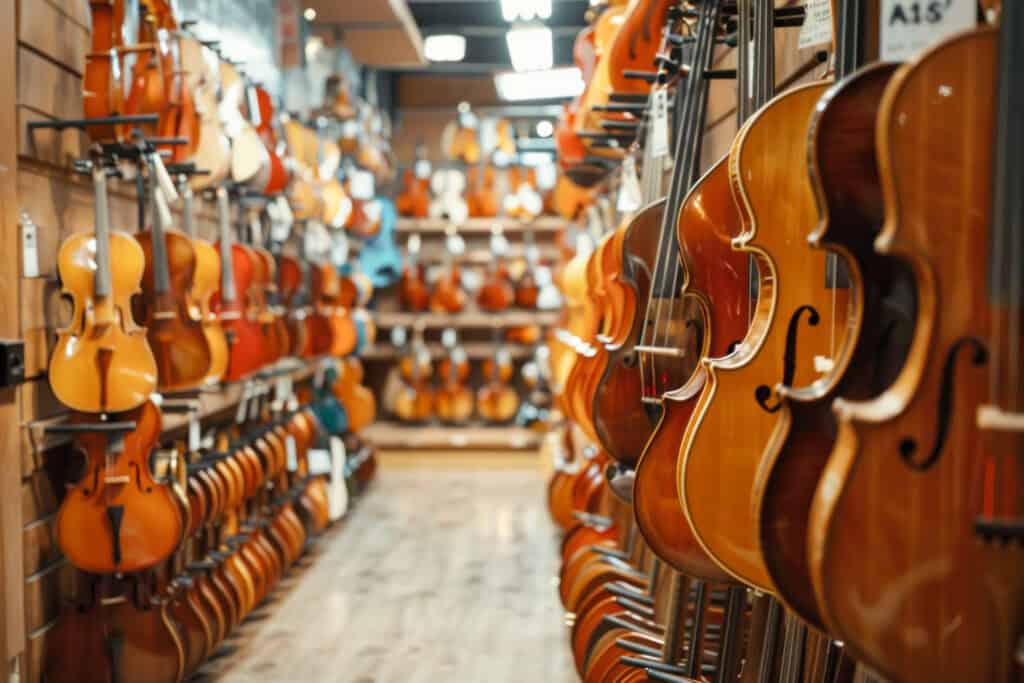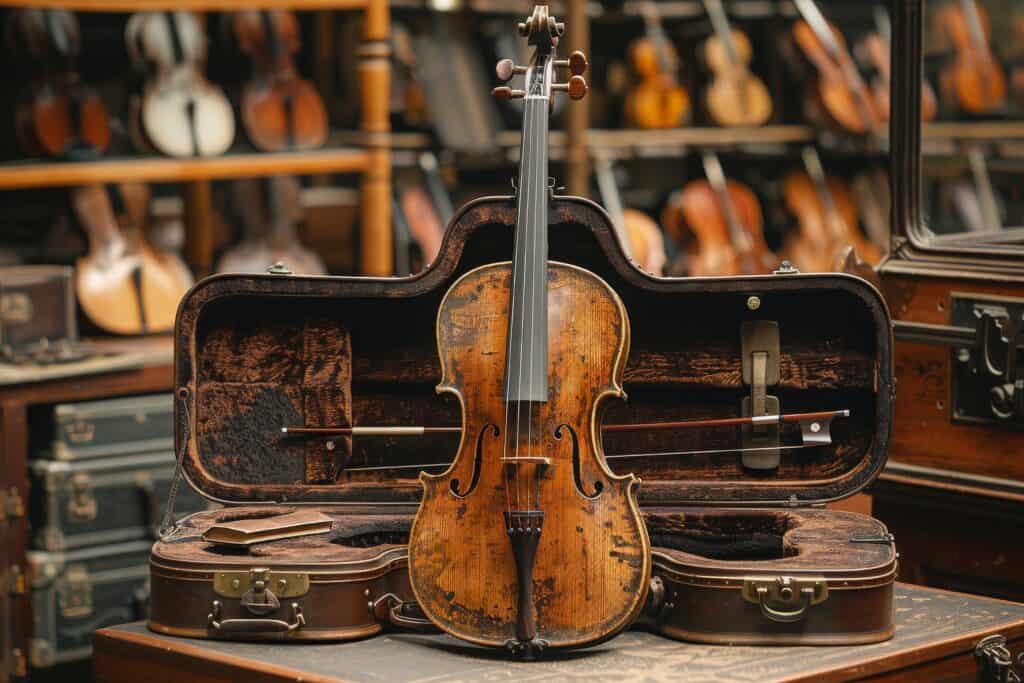Buying your first violin is an important step for any aspiring musician. It’s a significant investment, both financially and in terms of your musical journey. But with so many options out there, from student models to professional instruments, knowing where to start can be tricky.

Violins elegantly showcased on a music stores wall, showcasing the beauty of musical instruments and artistry
And so, this violin buying checklist is here to help first-time buyers like you make an informed decision and find the perfect violin to suit your needs.
1. Research Different Violin Sizes
Before you start shopping at the violin shop, it’s important to know that violins aren’t one-size-fits-all. The right size for you depends on your arm length and age. While most adults use full-size (4/4) violins, smaller sizes are available for children and petite adults. To find your ideal fit, measure from your neck to the middle of your left palm with your arm fully extended. This measurement is key to determining the correct violin size.
Reputable violin shops, such as Peter Prier & Sons Violins, can guide you through this process and help you try different sizes. These shops understand that a properly sized instrument is crucial for comfort, playability, and developing good technique.
2. Set A Realistic Budget
Violin prices span a wide range, from a few hundred to tens of thousands of dollars. As a beginner, you don’t need to splurge on a top-tier new instrument, but it’s smart to invest in a quality violin that will support your learning journey.
Consider your financial comfort zone and set a budget accordingly. Remember to factor in additional costs beyond the instrument itself – you’ll need a good bow, case, and various accessories. A well-planned budget ensures you get the right violin that balances quality and affordability.
3. Choose Between New and Used Violins
When choosing a violin, you’ll face the classic dilemma: new or used? Each has its advantages. New violins come with peace of mind – no hidden damage and often a warranty to boot. They’re ready to play right out of the box.
Used violins, however, can be hidden gems. They often offer better quality for your money, especially if well-maintained. But beware: if you’re eyeing a used instrument, get a professional luthier to give it a once-over. Their trained eye can spot potential issues and confirm you’re getting a good deal. Whichever route you choose, the goal is the same: finding a reliable instrument that fits your budget and helps you grow as a musician.
4. Assess The Violin’s Construction
A violin’s quality isn’t just about its sound. It’s in the details of its construction. As you browse, train your eye on a few key elements. Run your fingers along the seams; they should be even and tight. The varnish should have a smooth, consistent finish. Give the pegs a gentle twist; they should turn smoothly and fit snugly.
Also, take a close look at the bridge, as it’s a crucial component that should be carefully shaped and positioned. Don’t forget the fingerboard. A quick glance down its length will tell you if it’s straight and free of bumps or dips. These might seem like small details, but they add up to making a big difference in how the violin plays and sounds.
5. Listen To the Violin’s Sound
Each violin has its unique voice. Play the instrument yourself if you can, or have someone else play it for you. Listen for a clear, resonant tone that’s pleasing to your ear. Pay attention to how the violin sounds across all four strings and in different positions. A good violin should produce a balanced sound and good tone quality throughout its range.
6. Evaluate The Violin’s Playability
Just as important as the sound is how easy the violin is to play. Ensure the strings aren’t too high off the fingerboard, which can make playing difficult and strain your fingers. The pegs should turn smoothly but hold their position securely, preventing the strings from slipping out of tune.
Additionally, the chin rest and shoulder rest (if included) should feel comfortable and provide good support while playing. Remember, a violin that’s difficult to play can hinder your progress and enjoyment.
7. Consider The Bow
A high-quality bow is essential for producing a beautiful sound on your violin. When inspecting a bow, look for a straight shaft, evenly distributed horsehair, and appropriate tension. Ensure that the hair is not too loose or too tight, as this can affect the sound and playability.
Many beginners start with a brazilwood bow, which offers a good balance of quality and affordability. As your skills improve and you become more demanding of your instrument, you may consider upgrading to a Pernambuco or carbon fiber bow, which is known for its superior sound and durability.
8. Inspect The Case
A sturdy violin case is essential for protecting your violin and accessories. Look for a case that fits your instrument snugly and offers ample padding. Hard cases provide the most robust protection, but they can be heavier. Shaped cases offer a good balance of protection and portability. Ensure the case has compartments for your bow and accessories, such as rosin, a cleaning cloth, and extra strings.
Investing in a quality case will help preserve your violin’s value and ensure it remains in excellent condition for years to come.
9. Factor In Accessories
While shopping for your violin, don’t forget the necessary accessories. You’ll need rosin for your bow, a soft cloth for cleaning, and a music stand for practice. Consider purchasing a shoulder rest if one isn’t included with the violin. These accessories might seem minor, but they’re essential for proper violin care and practice.
10. Seek Expert Advice
If you’re unsure about any aspect of buying a violin, don’t hesitate to seek expert advice. Visit reputable music stores and talk to experienced violinists or your violin teacher. They can provide valuable insights and help you in your buying decision. Some stores even offer trial periods, allowing you to take the violin home and play it for a few days before making a final decision.
11. Read Customer Reviews
Today, you can easily access a wealth of information from other violin buyers using the internet. So, read customer reviews of the violins you’re considering, but be discerning. Look for detailed reviews that discuss the instrument’s sound quality, durability, and overall value. Keep in mind that personal preferences vary, so focus on consistent themes across multiple reviews.
12. Consider Future Upgrades
While you’re buying your first violin, it’s worth thinking about the future. As you progress in your violin lessons, you might want to upgrade certain parts of your instrument. Look for violins that allow for easy upgrades of the strings, bridge, or even the entire instrument. This flexibility can save you money in the long run and allow your instrument to grow with your skills.
Key Takeaway
With this comprehensive checklist, you’ll be more knowledgeable about choosing a violin that suits your needs and budget. Remember, the perfect violin is out there waiting for you. Take your time, trust your instincts, and enjoy the process of finding your musical companion.





